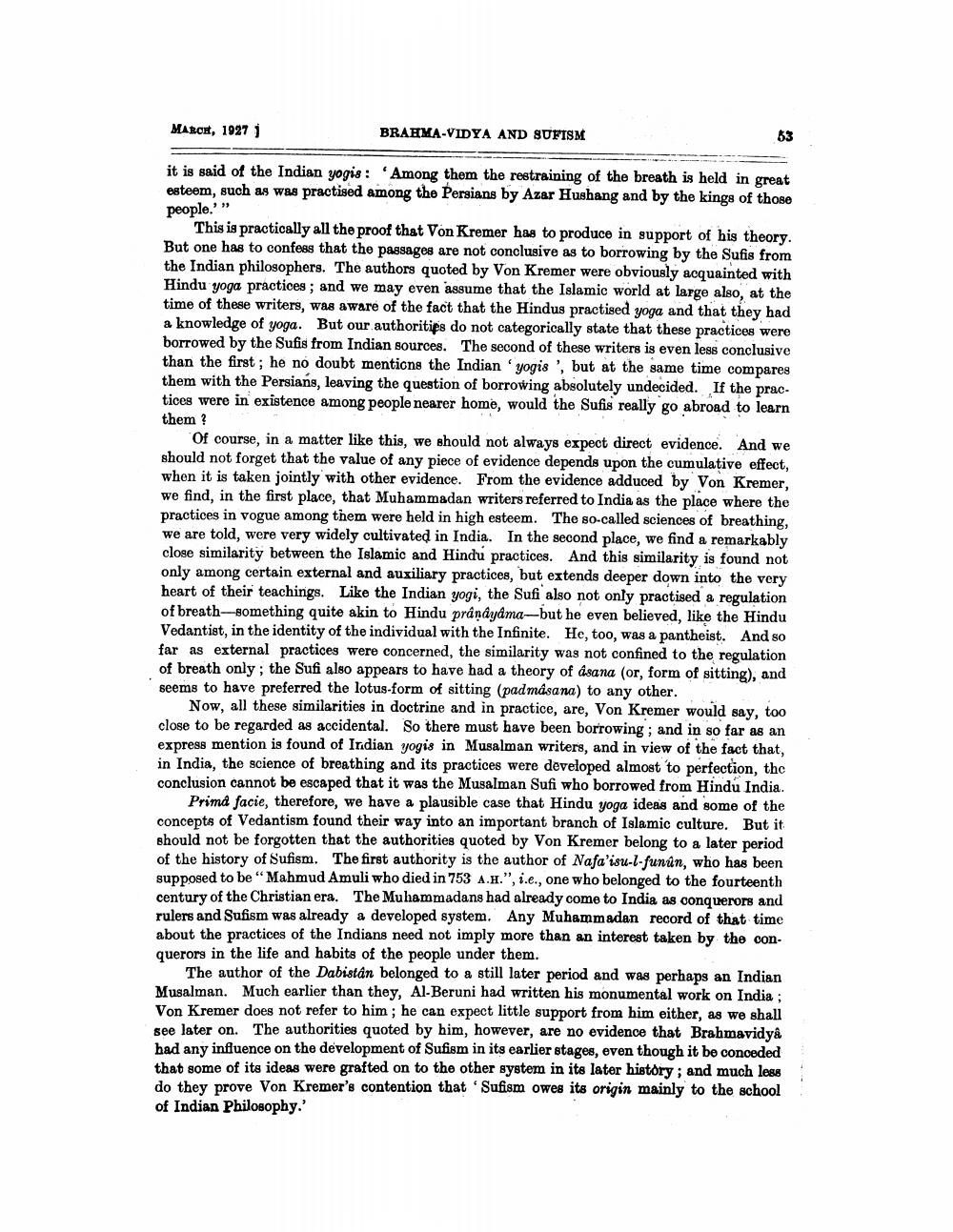________________
MARCE, 1927 j
BRAHMA-VIDYA AND SUFISM
it is said of the Indian yogis : Among them the restraining of the breath is held in great esteem, such as was practised among the Persians by Azar Hushang and by the kings of those
people. »
This is practically all the proof that Von Kremer has to produce in support of his theory. But one has to confess that the passages are not conclusive as to borrowing by the Sufis from the Indian philosophers. The authors quoted by Von Kremer were obviously acquainted with Hindu yoga practices; and we may even assume that the Islamic world at large also, at the time of these writers, was aware of the fact that the Hindus practised yoga and that they had a knowledge of yoga. But our authorities do not categorically state that these practices were borrowed by the Sufis from Indian sources. The second of these writers is even less conclusive than the first; he no doubt mentions the Indian 'yogis !, but at the same time compares them with the Persiang, leaving the question of borrowing absolutely undecided. If the practices were in existence among people nearer home, would the Sufis really go abroad to learn them?
Of course, in a matter like this, we should not always expect direct evidence. And we should not forget that the value of any piece of evidence depends upon the cumulative effect, when it is taken jointly with other evidence. From the evidence adduced by Von Kremer, we find, in the first place, that Muhammadan writers referred to India as the place where the practices in vogue among them were held in high esteem. The so-called sciences of breathing, we are told, were very widely cultivated in India. In the second place, we find a remarkably close similarity between the Islamic and Hindu practices. And this similarity is found not only among certain external and auxiliary practices, but extends deeper down into the very heart of their teachings. Like the Indian yogi, the Sufi also not only practised a regulation of breath-something quite akin to Hindu prándydma--but he even believed, like the Hindu Vedantist, in the identity of the individual with the Infinite. He, too, was a pantheist. And so far as external practices were concerned, the similarity was not confined to the regulation of breath only; the Sufi also appears to have had a theory of asana (or, form of sitting), and seems to have preferred the lotus-form of sitting (padmasana) to any other.
Now, all these similarities in doctrine and in practice, are, Von Kremer would say, too close to be regarded as accidental. So there must have been borrowing; and in so far as an express mention is found of Indian yogis in Musalman writers, and in view of the fact that, in India, the science of breathing and its practices were developed almost to perfection, the conclusion cannot be escaped that it was the Musalman Sufi who borrowed from Hindu India.
Primd facie, therefore, we have a plausible case that Hindu yoga ideas and some of the concepts of Vedantism found their way into an important branch of Islamic culture. But it should not be forgotten that the authorities quoted by Von Kremer belong to a later period of the history of Sufism. The first authority is the author of Nafa'isu-l-funún, who has been supposed to be “Mahmud Amuli who died in 753 A...", i.e., one who belonged to the fourteenth century of the Christian era. The Muhammadans had already come to India as conquerors and rulers and Sufism was already a developed system. Any Muhammadan record of that time about the practices of the Indians need not imply more than an interest taken by the conquerors in the life and habits of the people under them.
The author of the Dabistan belonged to a still later period and was perhaps an Indian Musalman. Much earlier than they, Al-Beruni had written his monumental work on India ; Von Kremer does not refer to him; he can expect little support from him either, as we shall see later on. The authorities quoted by him, however, are no evidence that Brahmavidya had any influence on the development of Sufism in its earlier stages, even though it be conceded that some of its ideas were grafted on to the other system in its later history, and much less do they prove Von Kremer's contention that 'Sufism owes its origin mainly to the school of Indian Philosophy.'




